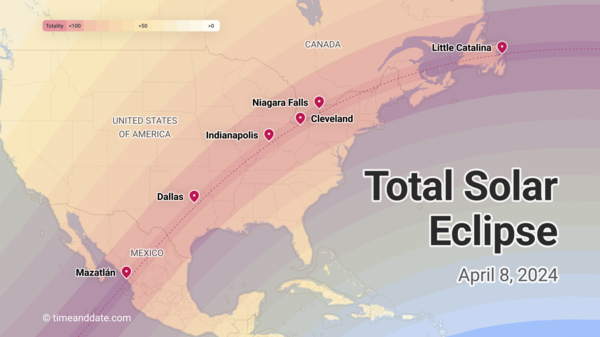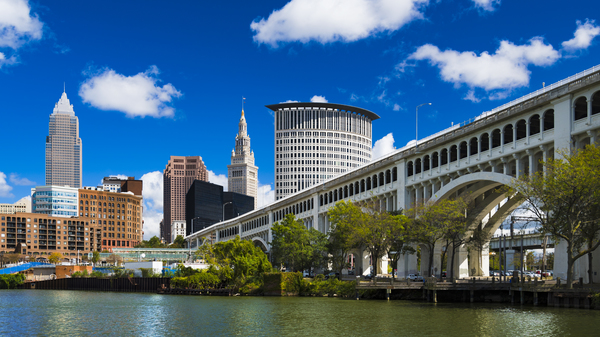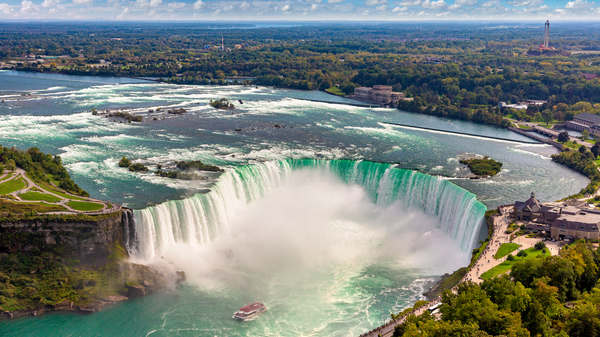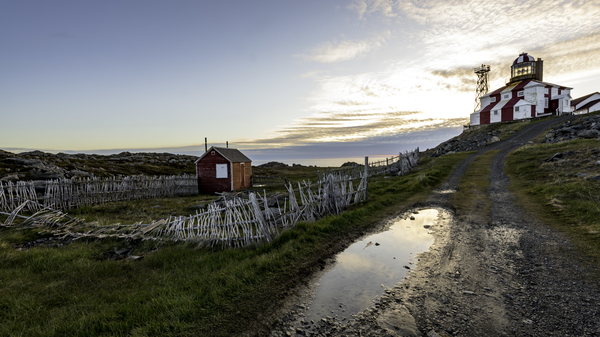The 7 Best Places to See the 2024 Total Solar Eclipse
Are you gearing up to see the total solar eclipse in April? We’ve collected some of the best spots to see totality, and the tools to find your perfect location.


The total solar eclipse on April 8 runs through Mexico, the USA—from Texas to Maine—and Canada. The darkest red band is the path of totality, and the lighter shaded areas get a partial eclipse. Find your location in our eclipse map!
©timeanddate.com
On April 8, 2024, the Moon will cross the face of the Sun, and a total solar eclipse will sweep across North America.
The total phase of the eclipse, where the Moon completely covers the Sun, is visible from a narrow path of totality starting in Mexico and then going through the 15 US states of Texas, Oklahoma, Arkansas, Missouri, Kentucky, Tennessee (small part), Illinois, Indiana, Ohio, Michigan (small part), Pennsylvania, New York, Vermont, New Hampshire, and Maine.
In Canada, totality can be seen in Ontario, Quebec, New Brunswick, Prince Edward Island, Nova Scotia, and Newfoundland and Labrador.
Worldwide, from start to finish, the whole eclipse will last around five hours, with up to four minutes and 30 seconds of totality in some locations.
How San Antonio lost the 2024 Great American Eclipse
1. Be the First in Mazatlán, Mexico
Unless you’re in a boat (or a plane) in the Pacific Ocean, Mazatlán in Mexico is the place to be if you want to be the first to see the eclipse.
Eclipse facts:
| Location: | Mazatlán, Sinaloa, Mexico |
|---|---|
| Totality time: | 4 min, 20 sec |
| Partial starts: | 9:51 am, local time |
| Totality starts: | 11:07 am, local time |
| Partial ends: | 12:32 pm, local time |
| Cloud cover: | 25% (since 2000) |
| Weather: | 14-day forecast |
The Sociedad Astronómica Mazatleca, the astronomy association in Mazatlán, has its hands full, welcoming both the Mexican and international astronomical community to their hometown, as well as people descending on the city to see the eclipse.
“People are coming from NASA, the European Space Agency, South America, Japan, Finland, and more. And we don’t know how many people will turn up to see the eclipse. Will it be 10,000 or 20,000?” David Esquivel, the president of the association, told us on a call a few weeks back.
We wish our friends good luck and clear skies.
What to look for during a total eclipse: First contact—the moment the Moon takes a bite out of the Sun and the eclipse has begun.
2. Texas Is the Heart of the Eclipse

Texas is smack bang in the middle of this eclipse, and Dallas and surrounding areas will get up to 4 minutes of totality.
©iStockphoto.com/travelview
Although around 43,000,000 people live in the path of totality, many will flock to Texas for this eclipse. There are several reasons why the Lone Star State is popular with the eclipse crowds.
Eclipse facts:
| Location: | Llano, Texas, USA |
|---|---|
| Totality time: | 4 min, 24 sec |
| Partial starts: | 12:16 pm, local time |
| Totality starts: | 1:34 pm, local time |
| Partial ends: | 2:57 pm, local time |
| Cloud cover: | 49% (since 2000) |
| Weather: | 14-day forecast |
The center line cuts right through the middle of the state, giving many options for smaller and larger locations to view totality. Austin is located toward the edge of the eclipse path with 1 minute and 46 seconds of totality. The Dallas to Fort Worth area, home to more than 7.5 million people, is very close to the center line with up to 4 minutes of totality.
Texas has the longest totality durations in the US because the state is close to the global maximum of the eclipse (it happens in Mexico). Near the beginning and end of the path of totality, the Moon’s shadow skims more quickly over Earth’s surface. Head to Kerrville for 4 minutes and 25 seconds of totality.
The chance of clear skies is higher in Texas as well—the further southwest you go, the less chance there is for clouds. On the Mexican border, the chance of clouds is about 40%, compared to more than 70% on the northeast coast of North America. Follow this link to our eclipse map and find the cloud cover layer to compare the chances of cloud cover at different locations.
timeanddate.com will be streaming live from Llano. It will be our 25th live stream!
What to look for during a total eclipse: the Sun’s corona—the ghostly halo that surrounds the Sun can only be seen during a total solar eclipse.


The path of totality goes straight through the heart of Texas, providing many potential locations to see totality. Try our eclipse map and use the layers on the side to find the path of totality, the central line, and the cloud cover to find your perfect location.
©timeanddate.com
3. Speeding Through Indianapolis
Crowds are expected at the famous Indianapolis Motor Speedway as the eclipse speeds its way through the North American continent. And the Moon’s umbral shadow really is speeding along now as it’s moving away from the global maximum (the eclipse shadow moves faster at the beginning and end of an eclipse).
Eclipse facts:
| Location: | Indianapolis, Indiana, USA |
|---|---|
| Totality time: | 3 min, 51 sec |
| Partial starts: | 1:50 pm, local time |
| Totality starts: | 3:06 pm, local time |
| Partial ends: | 4:23 pm, local time |
| Cloud cover: | 60% (since 2000) |
| Weather: | 14-day forecast |
For any solar eclipse, it’s crucial to be serious about eye safety: NEVER look at the Sun without proper eye protection.
There is one exception to the rule to be exercised with caution:
During the brief moments of totality, when the Sun is completely covered, and the ghostly solar corona becomes visible around the Moon, eclipse glasses can be safely removed—in fact, if you don’t take off your eye protection, you won’t be able to see the solar corona.
What to look for during a total eclipse: the Diamond Ring—the corona forms a ring around the dark Moon, while the Sun dazzles like a jewel.
4. Along Lake Erie in Ohio

From Cleveland, Ohio, and along the southern shore of Lake Erie, there are plenty of prime locations to catch the last total solar eclipse in the US until 2033.
©iStockphoto.com/Davel5957
The Cleveland side of the shore of Lake Erie offers multiple locations close to the center line, away from the big city crowds.
Eclipse facts:
| Location: | Cleveland, Ohio, USA |
|---|---|
| Totality time: | 3 min, 50 sec |
| Partial starts: | 1:59 pm, local time |
| Totality starts: | 3:13 pm, local time |
| Partial ends: | 4:29 pm, local time |
| Cloud cover: | 63% (since 2000) |
| Weather: | 14-day forecast |
We’re getting into cloud country, and as we move northeast in the eclipse path, we need to get a bit luckier with the weather as, historically, it has been cloudy over 60% of the days since 2000 in this part of the US.
That said, you only need a break in the clouds to see the eclipse over the majestic lake.
Our weather services are an excellent aid to help you plan your travels from 14 days out, right up to hour-by-hour on eclipse day.
What to look for during a total eclipse: Baily’s Beads—as the Sun streams through the valleys along the edge of the Moon, beads of sunlight appear just before and after totality.
When is the next total solar eclipse in the US?
5. Set the Scene in Niagara Falls

Niagara Falls in Ontario, Canada, is definitely one of the more spectacular places to see this eclipse.
©iStockphoto.com/bloodua
Nicknamed the Great North American Eclipse for good reason, the eclipse now crosses into Canada with the Moon’s umbra—its darkest shadow—hitting scenic Niagara Falls.
Eclipse facts:
| Location: | Niagara Falls, Ontario, Canada |
|---|---|
| Totality time: | 3 min, 31 sec |
| Partial starts: | 2:04 pm, local time |
| Totality starts: | 3:18 pm, local time |
| Partial ends: | 4:31 pm, local time |
| Cloud cover: | 65% (since 2000) |
| Weather: | 14-day forecast |
There’s nothing like a bit of nature to upstage nature, right? Niagara Falls definitely sets the scene for a spine-tingling, magical place to experience totality.
One way to describe the “magic” that happens during totality is that it is both completely strange and vaguely familiar at the same time.
As the Moon starts covering most of the Sun, it feels a bit like twilight, and nature reacts accordingly. Birds fly around looking for a tree to sleep in, and dogs start barking. As for our human nature, the awe of night in the middle of the day plays into the magic—when the Moon covers the Sun completely, it’s about as dark as during a Full Moon night.
What to look for during a total eclipse: feel the temperature start to drop from about 30 minutes before totality until the New Moon completely covers the Sun.
6. Last Chance to See in Newfoundland

Cape Bonavista lighthouse in Newfoundland and Labrador, Canada, will be one of the last places to see the total solar eclipse in 2024.
©iStockphoto.com/jimfeng
Eclipse facts:
| Location: | Little Catalina, Newfoundland and Labrador, Canada |
|---|---|
| Totality time: | 2 min, 53 sec |
| Partial starts: | 4:09 pm, local time |
| Totality starts: | 5:13 pm, local time |
| Partial ends: | 6:17 pm, local time |
| Cloud cover: | 78% (since 2000) |
| Weather: | 14-day forecast |
The people in the village of Little Catalina on Newfoundland Island get to be some of the last to say goodbye to the Great North American Eclipse.
A total solar eclipse lasts from sunrise to sunset on the daytime side of Earth. After the Moon’s umbral shadow leaves Canada’s easternmost coast, the Sun will set in the Atlantic Ocean.
The next chance to see a total solar eclipse on Earth will be in August 2026, when the path of totality goes through Greenland, Iceland, and Spain.
What to look for during a total eclipse: Fourth contact—the moment the Moon’s disc leaves the Sun and the eclipse is over for this time.
7. Stay Right Where You Are
If you are not in the path of totality, you can still see a partial solar eclipse that covers almost all of North America, and a sliver of South America and Europe.
In fact, around 650 million people can see a partial eclipse—just ensure you are protecting your eyes.
And if all else fails, we will be in the thick of it, streaming it live to you.